黑龙江大学跨文化案例分析Cases
- 格式:doc
- 大小:44.00 KB
- 文档页数:4
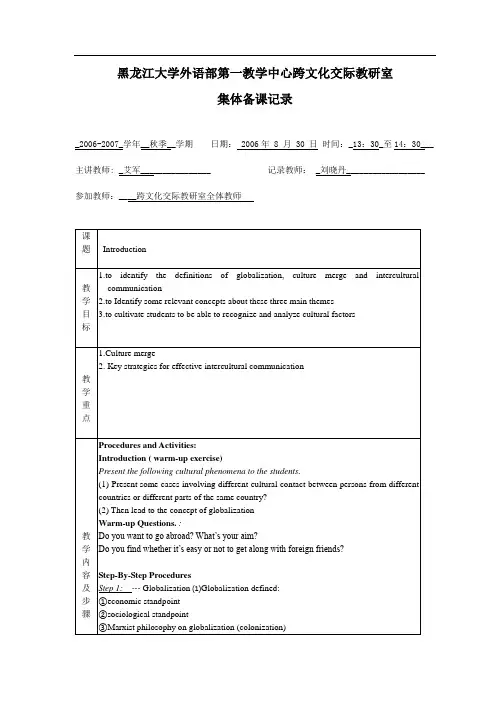
黑龙江大学外语部第一教学中心跨文化交际教研室集体备课记录_2006-2007_学年__秋季__学期日期: 2006年 8 月 30 日时间:_13:30_至14:30___ 主讲教师: _艾军________________ 记录教师: _刘晓丹__________________ 参加教师:____跨文化交际教研室全体教师黑龙江大学外语部第一教学中心跨文化交际教研室集体备课记录_2006-2007学年__秋季__学期日期:2006年 8 月 30 日时间:_13:30_至14:30__主讲教师: _常开媛__________ 记录教师: ___张知博________________参加教师:____跨文化交际教研室全体教师黑龙江大学外语部第一教学中心跨文化交际教研室集体备课记录_2006-2007_学年__秋季__学期日期: 2006年 9 月 6 日时间:_13:30_至14:30___ 主讲教师: _艾军________________ 记录教师: _董璇 __________________ 参加教师:____跨文化交际教研室全体教师黑龙江大学外语部第一教学中心跨文化交际教研室集体备课记录_2006-2007_学年__秋季__学期日期: 2006年月日时间:_13:30_至14:30___ 主讲教师: _______金梅_______ 记录教师: __________________参加教师:____跨文化交际教研室全体教师黑龙江大学外语部第一教学中心跨文化交际教研室集体备课记录2006-2007学年秋季学期日期:2006年9 月 25日时间:14:00至15:00 主讲教师: 李晓光记录教师:参加教师:跨文化教研室全体教师黑龙江大学外语部第一教学中心跨文化交际教研室集体备课记录_2006-2007_学年__秋季__学期日期: 2006年 9 月 27 日时间:_13:30_至14:30___ 主讲教师: _宋冰________________ 记录教师: _刘晓丹__________________ 参加教师:____跨文化交际教研室全体教师黑龙江大学外语部第一教学中心跨文化交际教研室集体备课记录_2006-2007_学年__秋季__学期日期: 2006年 10月 18日时间:_13:30_至14:30___ 主讲教师: 国玮秋________________ 记录教师:刘洋参加教师:____跨文化交际教研室全体教师黑龙江大学外语部第一教学中心跨文化交际教研室集体备课记录__2006-2007____学年___秋学期日期:年月日时间:______至_______ 主讲教师: ___王凤____ 记录教师: ___王玉双________________参加教师:______跨文化交际教研室全体教师黑龙江大学外语部第一教学中心跨文化交际教研室集体备课记录_2006-2007_学年__秋季__学期日期: 2006年 10 月 25 日时间:_13:30_至14:00___ 主讲教师: _杨白________________ 记录教师: _杨白__________________参加教师:____跨文化交际教研室全体教师黑龙江大学外语部第一教学中心跨文化交际教研室集体备课记录_2006-2007_学年__秋季__学期日期: 2006年 10 月 25 日时间:_13:30_至14:00___ 主讲教师: _杨白________________ 记录教师: _杨白__________________参加教师:____跨文化交际教研室全体教师黑龙江大学外语部第一教学中心跨文化交际教研室集体备课记录_2006-2007_学年__秋季__学期日期: 2006年 11 月 29 日时间:_13:30_至14:30___主讲教师: _张丽娇________________ 记录教师: _艾军__________________参加教师:跨文化交际教研室全体教师黑龙江大学外语部第一教学中心跨文化交际教研室集体备课记录_2006-2007_学年__秋季__学期日期: 2006年 12 月 6 日时间:_13:30_至14:30___ 主讲教师: _郑春梅________________ 记录教师: ____________参加教师:____跨文化交际教研室全体教师黑龙江大学外语部第一教学中心跨文化交际教研室集体备课记录_2006-2007_学年__秋季__学期日期: 2006年 12 月 7 日时间:_13:30_至14:30___ 主讲教师: _严明______________ 记录教师: _艾军__________参加教师:____跨文化交际教研室全体教师亲贤臣,远小人,此先汉所以兴隆也;亲小人,远贤臣,此后汉所以倾颓也。
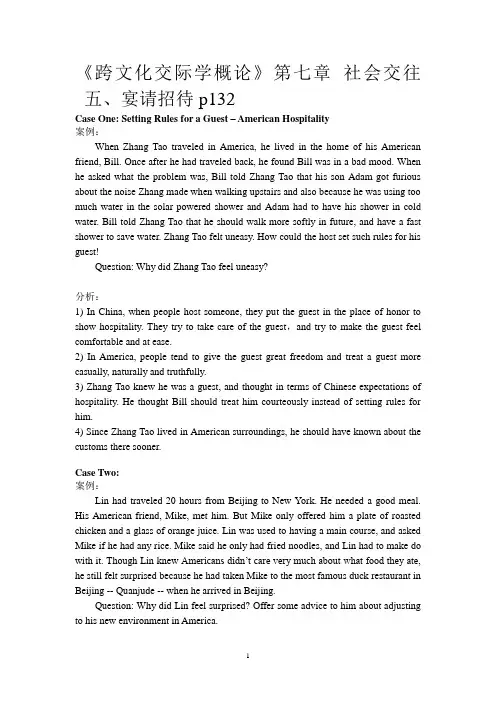
《跨文化交际学概论》第七章社会交往五、宴请招待p132Case One: Setting Rules for a Guest – American Hospitality案例:When Zhang Tao traveled in America, he lived in the home of his American friend, Bill. Once after he had traveled back, he found Bill was in a bad mood. When he asked what the problem was, Bill told Zhang Tao that his son Adam got furious about the noise Zhang made when walking upstairs and also because he was using too much water in the solar powered shower and Adam had to have his shower in cold water. Bill told Zhang Tao that he should walk more softly in future, and have a fast shower to save water. Zhang Tao felt uneasy. How could the host set such rules for his guest!Question: Why did Zhang Tao feel uneasy?分析:1) In China, when people host someone, they put the guest in the place of honor to show hospitality. They try to take care of the guest,and try to make the guest feel comfortable and at ease.2) In America, people tend to give the guest great freedom and treat a guest more casually, naturally and truthfully.3) Zhang Tao knew he was a guest, and thought in terms of Chinese expectations of hospitality. He thought Bill should treat him courteously instead of setting rules for him.4) Since Zhang Tao lived in American surroundings, he should have known about the customs there sooner.Case Two:案例:Lin had traveled 20 hours from Beijing to New York. He needed a good meal. His American friend, Mike, met him. But Mike only offered him a plate of roasted chicken and a glass of orange juice. Lin was used to having a main course, and asked Mike if he had any rice. Mike said he only had fried noodles, and Lin had to make do with it. Though Lin knew Americans didn’t care very much about what food they ate, he still felt surprised because he had taken Mike to the most famous duck restaurant in Beijing -- Quanjude -- when he arrived in Beijing.Question: Why did Lin feel surprised? Offer some advice to him about adjusting to his new environment in America.分析:1) 0n the topic of hospitality, the Chinese stress on warmth and demonstrating friendship. They take the guest to a famous or luxurious restaurant to have a very good (expensive) meal to show their hospitality. And the Chinese are used to having a big meal. The more dishes they put out,the greater the warmth and friendship they show.2) In western countries, people stress on freedom. They give the guest great freedom to choose their own foods. And westerners tend to have only one main course and some juice or dessert,which is viewed as casual in the eyes of the Chinese.3) Lin lived in American surroundings and should have adjusted himself quickly to the new world (lifestyle). He should have known the custom there first, and felt more at ease in Mike’s h ome.Case Three: Equality or Hospitality for Table Manners案例:Lin Hua has accompanied an American delegation to visit China. They have experienced the hospitality of the Chinese people. After returning to America, Linhua once visited them. They were so glad to meet again. Linhua offered to host the meal, but they refused. They ordered their own dish, and Linhua ordered her own. When footing the bill, they only paid their part,and no one wanted to pay for Linhua. Linhua found them so inhospitable, though she knew the Americans would usually pay for their own food.Question: Why did Linhua find them inhospitable?分析:1) In China, to show hospitality, people tend to host the meal. And if they cannot do this, they at least will struggle to pay for the guest.2) In America, people tend to pay for themselves to show equality and independence.3) Linhua knows this custom, but from a Chinese point of view, she still finds this hard to accept, and feels it a little inhospitable.Case Four:案例:I have an American friend. I have invited him several times, and at long last he invited me to his home one day. He told me to get there at 3 p m. I thought we could chat and have a meal together. I gave him a Chinese calendar, a woman’s scarf and a bottle of Chinese white wine. He only took out a dish of nuts, a plate of bread and a bottle of wine. After two hours’ chat, I found there was no hint of a meal and said good-bye to him. He only gave me a box of chocolate as a present for the New Year. After I got home, I found the box already been opened. I was very surprised, Question: What surprised me?分析:1) In China, a visit to home always includes a meal. And the guest always bringsa relatively expensive present to the host. And the present should be well wrapped or untouched.2) In the west, a visit to home only means a meeting, not necessarily including a meal. And the present is treated not as importantly as it is in China.3) I acted in a way that was based on Chinese customs, so I felt the American way was very interesting (unusual).Case Five: Way of Entertaining Guests in China ---- Drink more and more案例:Tom, an American, went to a Chinese home for the first time. He was offered some tea. Just when the first cup was about to finish, more tea was added. He drank the second cup. Then the cup was filled the third time. Then he drank it, then ⋯ until he was quite full. Tom was totally confused by the way of entertaining.Question: Why was Tom totally confused?分析:1) Traditional Chinese custom requires that during the course of entertaining, the host has to always pour more wine or tea to the guest’s glass or cup, and always adds more food to the guest’s plate or bowl without asking whether it’s wanted.2) Chinese guests know how to respond to this type of hospitality. They simply leave the wine, tea, or food in the container and stop having any more. But Tom, the American guest in the case didn’t know this.3) He followed the politeness rule of his culture: it’s not good manners to leave food in one’s own plate at a dinner table. Therefore, without any knowledge of the differences between the two cultures, an American guest would very likely suffer from either drinking or eating too much in such a situation.Case SixAs a foreign student at the University of Wisconsin in Madison, Keiko Ihara (Japanese) was on a strict budget. She had all her tuition and books paid for by scholarships and grants and until recently was comfortably housed in the dormitory. Wanting to live in the community rather than in the dormitory, she found a small apartment to share with a friend. Her college friends, knowing of her situation, offered to round up some of the necessary items for apartment living. Keiko politely declined, saying she could manage. Wanting to help out her friends found some old but still usable household appliances and furniture. Mary had an old desk that was in hergarage. Ed had some chairs from his uncle, and Joe and Marion had a few extra dishes. They cheerfully brought them over one day. Keiko seemed very embarrassed, but gracefully accepted them, sincerely and profusely thanked them.The following week they were each presented with a gift from Keiko. Mary got an ornate jewelry box, Ed a volume of woodcuts by a famous Japanese artist, and Joe and Marion a beautiful Japanese vase, all of which were of considerable worth and value, much more than the old things they had donated to her. They all protested that she could not afford to give such elaborate gifts; they really expected nothing as the household items were not really being used and they would rather have her use them. Keiko, however, insisted that they take the gifts. In the end, they accepted the gifts, although they all felt uncomfortable as they knew she was really sacrificing to give them.Questions:1. What do you think of Keiko insisting on giving valuable gifts to her college friends?2. Why did Keiko’s friends feel very uncomfortable when they received valuablegifts in return?分析:Keiko insists on giving valuable gifts to her college friends, because in countries like Japan, exchanging gifts is a strongly rooted social tradition. Should you receive a gift, and don’t have one to offer in return, you will probably create a crisis. If not as serious as a crisis, one who doesn’t offer a gift in return may be considered rude or impolite. Therefore, in Japan, gifts are a symbolic way to show appreciation, respect, gratitude and further relationship.Keiko obviously has taken those used items from Mary, Ed and Marion as gifts, for she probably doesn’t know that Americans frequently donate their used household items to church or to the community. Mary, Ed and Marion would never consider those used household items given to Keiko as gifts. No wonder they felt very uncomfortable when they received valuable gifts in return.Case SevenSelma, who is from the US, is in a student exchange program in Indonesia. One day, she was asked to attend a birthday party and she was delighted, for she was curious to know what an Indonesian birthday party was like. To her surprise, she was the only one that dressed in typically Western clothes. Although she had no strong reason to become uneasy, her uneasy feeling prevailed as the party was going on. To make herself feel better, she went to the food table and began to help herself. But, upon leaving the table, she tripped on the leg of a chair and spilled her drink on the floor. One of the girls stooped down to mop up the spill and everyone else laughed out loud. Selma, uncertain what to do next, quietly moved out of her way with her head lowered in shame.Questions:3. What functions does laughing serve in similar situations in China?4. What should we do to help ourselves or other people out of embarrassmentcaused by cultural differences in laughing?分析:Just like smile, laughing does not always serve the same function in different cultures. Interestingly, for us Chinese, laughing often has a special function on some tense social occasions. People may laugh to release the tension or embarrassment, to express their concern about you, their intention to put you at ease or to help you come out of the embarrassment. In this case, the people there were actually wishing to laugh with the American rather than laugh at her. Their laughing seemed to convey a number of messages: don‘t take it so seriously; laugh it off, it‘s nothing; such things can happen to any of us, etc. Unfortunately the American was unaware of this. She thought they were laughing at her, which made her feel more badly and angry, for in her culture laughing on such an occasion would be interpreted as an insulting response, humiliating and negative.。
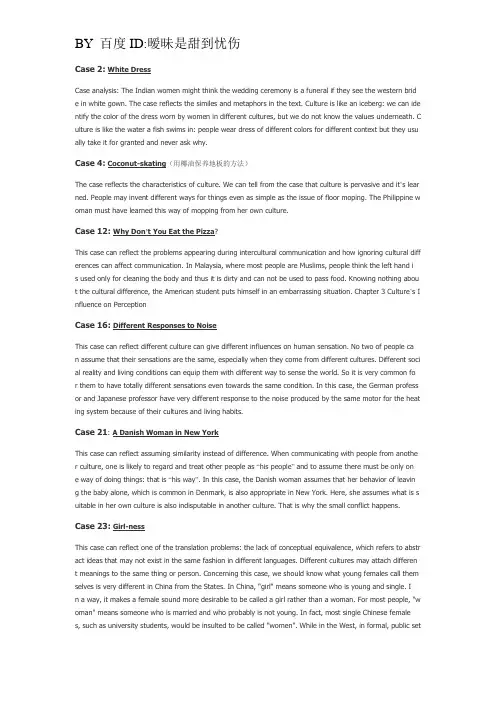
Case 2:White DressCase analysis: The Indian women might think the wedding ceremony is a funeral if they see the western brid e in white gown. The case reflects the similes and metaphors in the text. Culture is like an iceberg: we can ide ntify the color of the dress worn by women in different cultures, but we do not know the values underneath. C ulture is like the water a fish swims in: people wear dress of different colors for different context but they usu ally take it for granted and never ask why.Case 4:Coconut-skating(用椰油保养地板的方法)The case reflects the characteristics of culture. We can tell from the case that culture is pervasive and it’s lear ned. People may invent different ways for things even as simple as the issue of floor moping. The Philippine w oman must have learned this way of mopping from her own culture.Case 12: Why Don’t You Eat the Pizza?This case can reflect the problems appearing during intercultural communication and how ignoring cultural diff erences can affect communication. In Malaysia, where most people are Muslims, people think the left hand i s used only for cleaning the body and thus it is dirty and can not be used to pass food. Knowing nothing abou t the cultural difference, the American student puts himself in an embarrassing situation. Chapter 3 Culture’s I nfluence on PerceptionCase 16: Different Responses to NoiseThis case can reflect different culture can give different influences on human sensation. No two of people ca n assume that their sensations are the same, especially when they come from different cultures. Different soci al reality and living conditions can equip them with different way to sense the world. So it is very common fo r them to have totally different sensations even towards the same condition. In this case, the German profess or and Japanese professor have very different response to the noise produced by the same motor for the heat ing system because of their cultures and living habits.Case 21: A Danish Woman in New YorkThis case can reflect assuming similarity instead of difference. When communicating with people from anothe r culture, one is likely to regard and treat other people as “his people”and to assume there must be only on e way of doing things: that is “his way”. In this case, the Danish woman assumes that her behavior of leavin g the baby alone, which is common in Denmark, is also appropriate in New York. Here, she assumes what is s uitable in her own culture is also indisputable in another culture. That is why the small conflict happens.Case 23:Girl-nessThis case can reflect one of the translation problems: the lack of conceptual equivalence, which refers to abstr act ideas that may not exist in the same fashion in different languages. Different cultures may attach differen t meanings to the same thing or person. Concerning this case, we should know what young females call them selves is very different in China from the States. In China, "girl" means someone who is young and single. In a way, it makes a female sound more desirable to be called a girl rather than a woman. For most people, "w oman" means someone who is married and who probably is not young. In fact, most single Chinese female s, such as university students, would be insulted to be called "women". While in the West, in formal, public settings, it is customary to call any woman who is past puberty a woman, even though she may not be legally ol d enough to vote, marry, purchase alcoholic beverages, drive a car, or sign a contract. This terminology beca me widespread during the "women's liberation movement in the 1960s". The term "'girl" is sometimes interpre ted to be demeaning or disrespectful.Case 24:An Unfair DecisionThis case reflects prejudice, which involves an unfair, biased, or intolerant attitude towards another group of p eople. In this case, Mr. Bias decided to select someone else, instead of applicant from the country Levadel, fo r the position. That is just because he holds prejudice towards people from the country Levadel.Case 25:Success StoryOne of the sources of the frustration and misunderstandings that occurred in this case was different notions o f what was verbally relevant. In this case, Mary was expecting a much more direct response to her questio n. Ms. Goshima, however, was uncomfortable with the question and felt her response should be very indirec t and establish a proper sense of modesty before revealing the answer to the question. If Mary had been mor e patient, she would have eventually heard the answer to her question, but she was not really paying attentio n when it finally came because she felt that Ms. Goshima's comments weren't really relevant to her query.Case 33:Are Americans Indifferent?This case can reflect different nonverbal communication patterns exist in the actual intercultural communicatio n, especially facial expression differ according to different pared to most Chinese, Americans lik e to smile a lot and to have causal and rich facial expressions in their daily lives, even though they have som e misfortune. In this case, because of the different opinions about facial expressions in intercultural communic ation, the American lady talked about her father’s sickness and death in a smiling way to show she still has th e optimistic way to treat the future life, which is misunderstood as being indifferent and selfish by the Chines e.Case 36:Don’t Put Your Hand on My ArmThis case can reflect different cultures have different opinions to spatial relations. Different cultures have ver y different opinions about an individual’s unconsciously structuring the microspace immediately surrounding th e physical body. Some cultures can have relatively close distance when communicating while other cultures ca nnot. Some western cultures consider body touch between people of the same gender to be cultural taboo an d a symbol of being homosexual.In this case, Sam is from western cultures and knows the social taboo of bod y touch very clearly,so he wouldn’t let others misunderstand Mark’s close body distance and touch with hi m, even though Mark from Chile doesn’t know the cultural taboo at all.Case 41: Getting FrustratedJay was frustrated in large part because many of the norms he was used to didn't apply in Saudi Arabia, and many Saudi norms did not make sense to him. Much of the business done in Saudi Arabia depends on baksh eesh, a type of kickback to a middleman (and it is a man), who facilitates contacts between potential busines s partners. The middleman is doing a service and expects to get paid for it. The more baksheesh the person gi ves, the more likely it is that the person will succeed, because the middleman will be sure to treat him very w ell. Giving baksheesh is a norm in the Saudi business community. In addition, Saudis believe that God gave us multifunctional hands and that the hand is our best tool for eating. However, they are also concerned with h ygiene. They reserve the left hand for cleaning themselves and use the right hand for eating. Saudis have a n umber of norms related to restricting male and female interaction that, within the context of their religious bel iefs, make perfect sense but would be very inappropriate to most Westerners.Case 43: The Improvement Does Not WorkFollowing their individualistic orientations, Mr. Patterson and Mr. Wyman were perfectly comfortable with the i dea of creating team leaders within the individual sales groups. However, as Park Young Sam mentions, doin g so upset the harmony of the groups, which in turn led to poor performance. In the United States, workers a re often motivated by the opportunity for promotion and advancement as this serves the individualistic drive f or individual achievement. In collectivistic cultures, however, workers may be motivated by being a part of a c ohesive and productive team. Individualism and collectivism are terms that describe whole cultures. But cultur es are not pure. Members of collectivist cultures may practice individualistic tendencies while members of indi vidualist cultures may value collectivist ideals. For example, Denmark is a country with both collectivistic and i ndividualistic tendencies. In Denmark, individual freedom is nurtured through a devotion to established traditi ons and customs. Regarding income and social rank, Danes are staunchly egalitarian. At the same time, howe ver, Danes consider themselves free to be nonconformist and to stand out from the group. In this way, Dane s may be at the theoretical midpoint of the individualism and collectivism cultural continuum.Case 44:When Shall We Meet For Dinner?Uncertainty avoidance orientation can be seen in this case. In the dialogue presented below,Kelly and Keiko ar e interacting about a dinner invitation. Kelly, from the United States, possesses a relatively low uncertainty av oidance index, while Keiko, from Japan, comes from a culture with a relatively high uncertainty avoidance ind ex.In the dialogue above, Keiko is confused by Kelly’s easygoing attitude toward the evening’s plans. Comin g from a high uncertainty-avoidant culture, Keiko would prefer to plan ahead to avoid uncertainty and prepar e her script for the evening. Kelly, on the other hand, is perfectly comfortable making plans based on how th e evening progresses. Without a plan, how will Keiko know how to act?Case 48:Gift from a ChineseChinese people love giving gifts. Usually, the value of the gift is an indication of how important the receiver i s in the sender’s eyes. Most people giving gifts are concerned about whether the gift will be seen as valuabl e enough. An inexpensive gift means a loss of face.Dongxie may have a practical reason in giving the ginsen g to his manager, but most Chinese will take it as something usual for a subordinate to do this to a manager o ut of a sign of respect.North American companies do occasionally receive gifts out of appreciation for the frien dship and assistance the manager may provide. Such gifts are treasured; however, the value usually is fairly s mall, a bottle of wine, a music CD, a small book, or other tokens.Case 50:Refuse to Be Treated?In the case just described, the U.S. American medical team system for making sense of the situation demande d that people be seen in order of the seriousness of their injuries or illness. Each person was considered as wo rthwhile as the next, and so seriousness of injury appeared to be a natural way to determine who was seen fir st. However, the cultural system working for those on the Virgin Islands demanded that elders be seen and tr eated first. Their position, age, and wisdom demanded respect. For younger members of the community to go ahead of them in a time of crisis was seen as extremely disrespectful.The conflict centered on efforts by eac h side to do what they perceived as good and morally responsible. Because the U.S. Americans were in a bett er position to adapt than an entire community that had just suffered great loss and were under extreme stres s, it was good that they were willing to do so. Sadly, this is not always the case.Case 54: A Fish out of WaterThis case reflects that the boy is experiencing culture shock, which may bring him some psychological sympto ms. Culture shock is virtually a communication problem which involves the depressed feelings accompanying a lack of understanding of the verbal and nonverbal communication of the host culture, its customs, as wel l as its value systems. Culture shock happens when people have to deal with a huge amount of new perceptu al stimuli that are difficult to understand and interpret because the cultural context has changed. In this cas e, when the American student feels that his familiar cues from his native culture is removed, he becomes to re ject the new environment and he displays some psychological symptoms due to culture shock.Case 55:Missing China!This case can reflect reverse culture shock. When people return home after an extended stay in a foreign cult ure, they experience another round of culture shock in their native culture and they must proceed through th e four stages of the U-curve pattern once again. In this case, John, whose comes from Canada, has been livin g in China for quite a long time and he has got familiar with the Chinese culture. Therefore, when he returns t o Canada, he cannot adapt well to his native culture.。
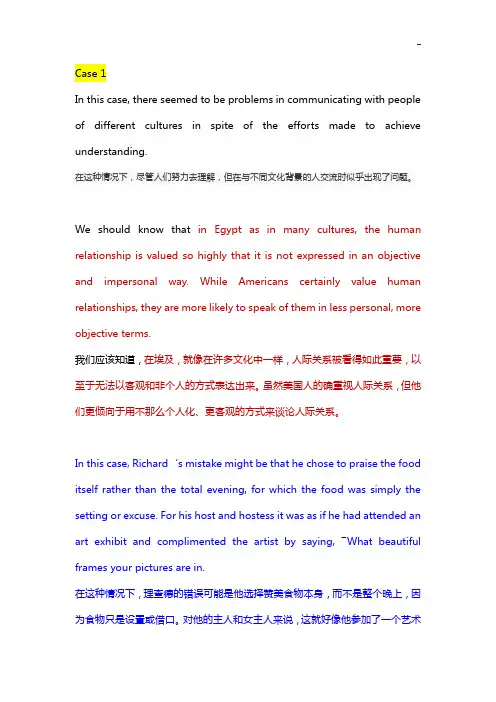
Case 1In this case, there seemed to be problems in communicating with people of different cultures in spite of the efforts made to achieve understanding.在这种情况下,尽管人们努力去理解,但在与不同文化背景的人交流时似乎出现了问题。
We should know that in Egypt as in many cultures, the human relationship is valued so highly that it is not expressed in an objective and impersonal way. While Americans certainly value human relationships, they are more likely to speak of them in less personal, more objective terms.我们应该知道,在埃及,就像在许多文化中一样,人际关系被看得如此重要,以至于无法以客观和非个人的方式表达出来。
虽然美国人的确重视人际关系,但他们更倾向于用不那么个人化、更客观的方式来谈论人际关系。
In this case, Richard‘s mistake might be that he chose to praise the food itself rather than the total evening, for which the food was simply the setting or excuse. For his host and hostess it was as if he had attended an art exhibit and complimented the artist by saying, ―What beautiful frames your pictures are in.在这种情况下,理查德的错误可能是他选择赞美食物本身,而不是整个晚上,因为食物只是设置或借口。
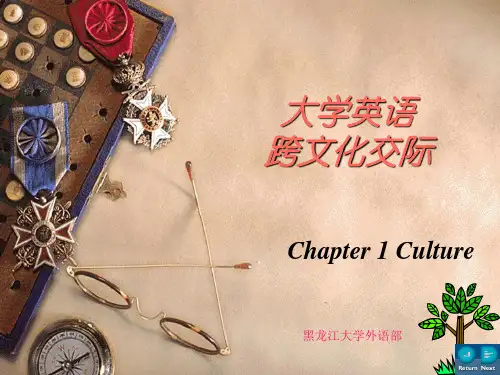
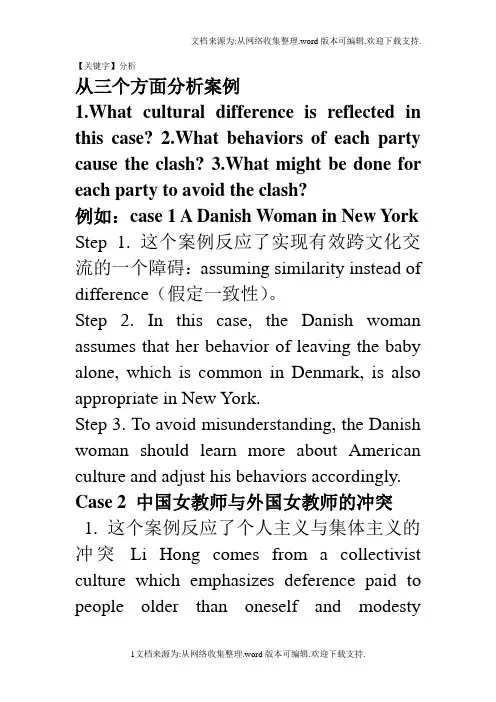
【关键字】分析从三个方面分析案例1.What cultural difference is reflected in this case?2.What behaviors of each party cause the clash?3.What might be done for each party to avoid the clash?例如:case 1 A Danish Woman in New York Step 1. 这个案例反应了实现有效跨文化交流的一个障碍:assuming similarity instead of difference(假定一致性)。
Step 2. In this case, the Danish woman assumes that her behavior of leaving the baby alone, which is common in Denmark, is also appropriate in New York.Step 3. To avoid misunderstanding, the Danish woman should learn more about American culture and adjust his behaviors accordingly. Case 2 中国女教师与外国女教师的冲突1. 这个案例反应了个人主义与集体主义的冲突Li Hong comes from a collectivist culture which emphasizes deference paid to people older than oneself and modestydisplayed on the part of the young. Maggy comes from an individualistic culture which values assertiveness and free expression of feelings.2.3.Case 3Susan Wood, a young American mother of a four-year-old boy, came to China for the first time. She wrote a letter to her parents for help. Dear Dad and Mom,I don’t feel happy in China. I am scared by how the Chinese treat Tommy. Tommy is already four years old. Whenever I take him outside, a lot of Chinese w hom I don’t know would fondle him, touching, patting, hugging or even kissing him. It seems that the Chinese are treating Tommy as a pet. I think they are very rude. What should I do?Best wishes,Susan1.This case reflects different attitudes towardsone stuff of people from different cultural backgrounds.此文档是由网络收集并进行重新排版整理.word可编辑版本!。
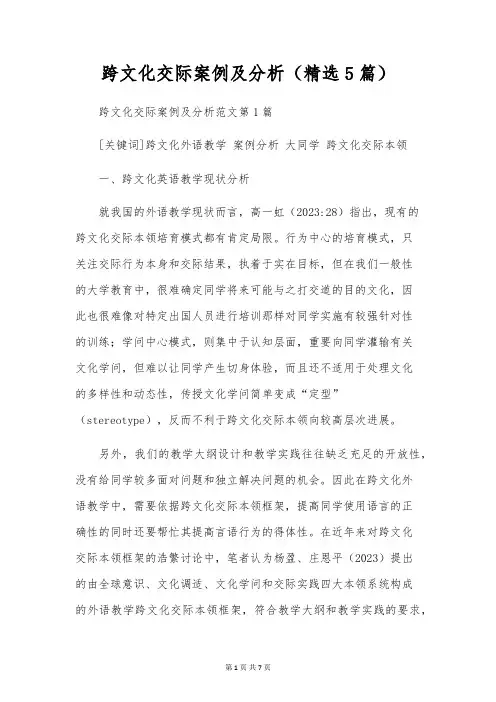
跨文化交际案例及分析(精选5篇)跨文化交际案例及分析范文第1篇[关键词]跨文化外语教学案例分析大同学跨文化交际本领一、跨文化英语教学现状分析就我国的外语教学现状而言,高一虹(2023:28)指出,现有的跨文化交际本领培育模式都有肯定局限。
行为中心的培育模式,只关注交际行为本身和交际结果,执着于实在目标,但在我们一般性的大学教育中,很难确定同学将来可能与之打交道的目的文化,因此也很难像对特定出国人员进行培训那样对同学实施有较强针对性的训练;学问中心模式,则集中于认知层面,重要向同学灌输有关文化学问,但难以让同学产生切身体验,而且还不适用于处理文化的多样性和动态性,传授文化学问简单变成“定型”(stereotype),反而不利于跨文化交际本领向较高层次进展。
另外,我们的教学大纲设计和教学实践往往缺乏充足的开放性,没有给同学较多面对问题和独立解决问题的机会。
因此在跨文化外语教学中,需要依据跨文化交际本领框架,提高同学使用语言的正确性的同时还要帮忙其提高言语行为的得体性。
在近年来对跨文化交际本领框架的浩繁讨论中,笔者认为杨盈、庄恩平(2023)提出的由全球意识、文化调适、文化学问和交际实践四大本领系统构成的外语教学跨文化交际本领框架,符合教学大纲和教学实践的要求,具较强可行性。
二、案例分析在跨文化英语教学中的作用目前跨文化英语教学普遍采纳的方法重要包括背景学问导入、文化内涵探究、案例分析、角色扮演及情景仿照、实例搜索等。
案例分析教学中将不同文化背景的语言特色、风土人情、历史事件和现实冲突等素材呈现于同学面前,是跨文化学问、意识、思维和交际本领的综合训练过程,能帮忙同学达到学习外语语言技能与培育跨文化交际本领有机结合的目的。
在谈到案例教学法时,陈建平(2023)强调:“案例是为适应特定的教学目的而编写的”,教学过程重要是“同学之间的讨论和辩论”,教学目的重要是“培育同学的本领”。
上述特点,使案例教学能很好适用于跨文化外语教学,它对培育本领的重视大过取得学问,成为语言文化学问向跨文化本领变化的有效途径。

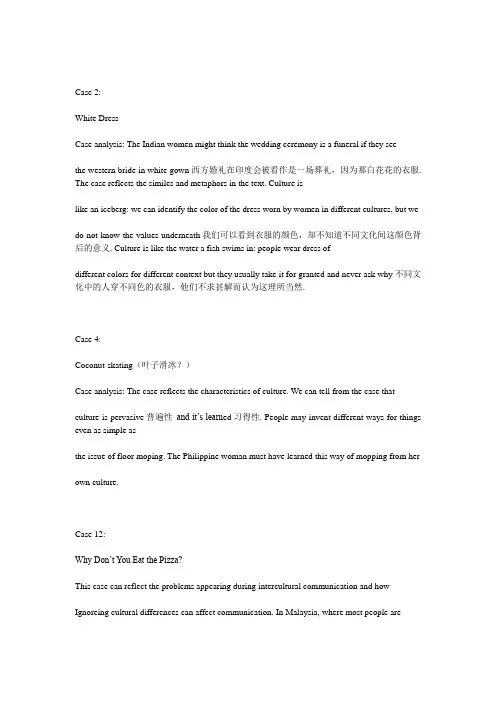
Case 2:White DressCase analysis: The Indian women might think the wedding ceremony is a funeral if they seethe western bride in white gown西方婚礼在印度会被看作是一场葬礼,因为那白花花的衣服. The case reflects the similes and metaphors in the text. Culture islike an iceberg: we can identify the color of the dress worn by women in different cultures, but wedo not know the values underneath我们可以看到衣服的颜色,却不知道不同文化间这颜色背后的意义. Culture is like the water a fish swims in: people wear dress ofdifferent colors for different context but they usually take it for granted and never ask why不同文化中的人穿不同色的衣服,他们不求甚解而认为这理所当然.Case 4:Coconut-skating(叶子滑冰?)Case analysis: The case reflects the characteristics of culture. We can tell from the case thatculture is pervasive普遍性and it’s learn ed习得性. People may invent different ways for things even as simple asthe issue of floor moping. The Philippine woman must have learned this way of mopping from her own culture.Case 12:Why Don’t Y ou Eat the Pizza?This case can reflect the problems appearing during intercultural communication and how Ignoreing cultural differences can affect communication. In Malaysia, where most people areMuslims, people think the left hand is used only for cleaning the body and thus it is dirty and can not be used to pass food. Knowing nothing about the cultural difference, the American student puts himself in an embarrassing situation尴尬的境地.Case 16:Different Responses反映to Noise噪音This case can reflect different culture can give different influences on human sensation感觉,感情. No two of people can assume假定that their sensations are the same, especially when they come from different cultures没有那两个人想的是一样的,更别说不同文化的人了.Different social reality and living conditions can equip them with different way to sense the world 不同的社会现实和居住环境会使人们对世界的看法不同. So it is very common for them to have totally different sensations even towards the same condition所以同一情况下人们的不同看法是非常常见的. In this case, the German professor and Japanese professor have very different response to the noise produced by the same motor for the heating system because of their cultures and living habits.由于德国鬼子和日本鬼子文化和居住习惯上的不同,德国鬼子和日本鬼子对于同一种噪音就有不同的看法,但他们还是鬼子。
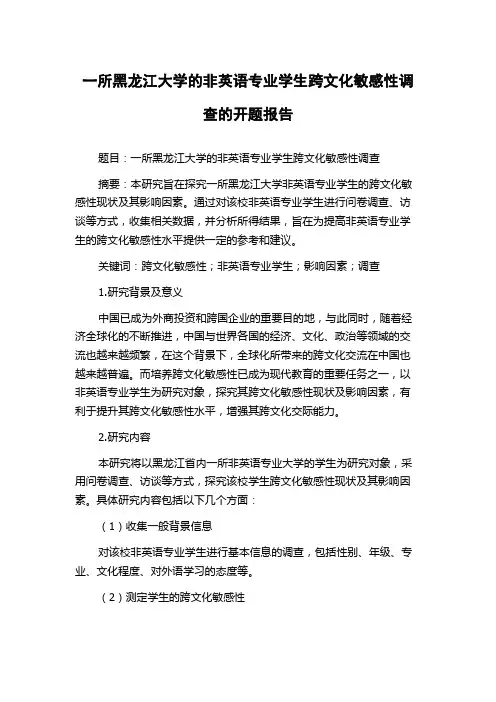
一所黑龙江大学的非英语专业学生跨文化敏感性调查的开题报告题目:一所黑龙江大学的非英语专业学生跨文化敏感性调查摘要:本研究旨在探究一所黑龙江大学非英语专业学生的跨文化敏感性现状及其影响因素。
通过对该校非英语专业学生进行问卷调查、访谈等方式,收集相关数据,并分析所得结果,旨在为提高非英语专业学生的跨文化敏感性水平提供一定的参考和建议。
关键词:跨文化敏感性;非英语专业学生;影响因素;调查1.研究背景及意义中国已成为外商投资和跨国企业的重要目的地,与此同时,随着经济全球化的不断推进,中国与世界各国的经济、文化、政治等领域的交流也越来越频繁,在这个背景下,全球化所带来的跨文化交流在中国也越来越普遍。
而培养跨文化敏感性已成为现代教育的重要任务之一,以非英语专业学生为研究对象,探究其跨文化敏感性现状及影响因素,有利于提升其跨文化敏感性水平,增强其跨文化交际能力。
2.研究内容本研究将以黑龙江省内一所非英语专业大学的学生为研究对象,采用问卷调查、访谈等方式,探究该校学生跨文化敏感性现状及其影响因素。
具体研究内容包括以下几个方面:(1)收集一般背景信息对该校非英语专业学生进行基本信息的调查,包括性别、年级、专业、文化程度、对外语学习的态度等。
(2)测定学生的跨文化敏感性采用跨文化敏感性测量工具(如Bennett模式等),纵向、纵向、横向比较和对照,来测量该校非英语专业学生的跨文化敏感性,包括几个核心维度:文化注意力、文化容忍性、文化判断力、文化自我启示力等方面。
(3)探究影响因素通过分析问卷调查和访谈结果,对该校学生的跨文化敏感性影响因素进行分析,包括教育、社会文化、家庭、地域等。
3.研究意义通过本研究,可以掌握该校非英语专业学生的跨文化敏感性现状及其影响因素,为该校非英语专业学生的跨文化教育提供参考,进而提升他们的跨文化交流能力,同时为其他非英语专业学生的跨文化教育提供参考和借鉴。

大学英语跨文化交际案例分析大学英语跨文化交际案例分析Case 2 (P8)White Dress女王的白色长裙:Case analysis: The Indian women might think the wedding ceremony is a funeral if they see the western bride in white gown. The case reflects the similes and metaphors in the text.案例分析:印度女人可能觉得婚礼是一个葬礼,如果他们看到西方的新娘的白色礼服。
这个案例反映了明喻和隐喻在文本。
Culture is like an iceberg: we can identify the color of the dress worn by women in different cultures, but we do not know the values underneath. Culture is like the water a fish swims in: people wear dress of different colors for different context but they usually take it for granted and never ask why.文化是像冰山:我们可以辨认颜色衣服的妇女所穿不同的文化,但我们不知道下面的值。
文化是像水鱼游在:人们穿不同颜色的衣服为不同的上下文,但他们通常是理所当然的,从不问为什么。
Case 4 (P18)Coconut-skating椰子-溜冰:Case analysis: The case reflects the characteristics of culture. We can tell from the case that culture is pervasive and it’s learned.案例分析:这个事件反映了文化的特点。
黑龙江大学跨文化交际英语复习总结(超全)跨文化考试总结考试构成:一、单选 1*10=10分。
(Choose the one that)其中有一部分是书中的概念。
二、判断1*10=10分。
(A—>true,B—>false) 课后习题第二大题,其中某些题是变动的。
要注重理解。
三、搭配1*20=20分。
matching 四组搭配,概念的对应,每一章课后的summary中的黑体字。
四、阅读理解1*20=20分。
四篇。
与课文中的专有词有关。
五、完型填空1*10=10分。
六、案例分析3*5=15分。
五个案例。
书中案例有四个,课外一个。
七、写作15分。
150+words。
可以准备一些跨文化、交际的文章。
四十分钟的写作时间。
8:00——8:40.作文提前收!注:前六大题是客观题即选择,只有写作是主观题。
课后题:(课后题第一第二大题老师也让多多关注,我这里就不多写啦,除了课后第一第二大题,我这里都全啦)1、P28——P302、P58——P613、P95——P974、P124——P1265、P159——P1626、P194——P1977、P237——P2408、P270——P2729、P304——P306所有概念关键词+考试范围内的CASE:Chapter 1 CultureKeywords(1) Culture (from intellectual perspective): Culture is “the arts and other mani festations of human intellectual achievement regarded collectively”(从知性角度定义文化:作为整体的人类智力成就的艺术和其他表现。
)(2) Culture (from anthropologic perspective): Culture consists of patterns, exp licit and implicit, of and for behavior acquired and transmitted by symbols, co nstituting the distinctive achievement of human groups, including their embod iments in artifacts; the essential core of culture consists of traditional ideas and especially their attached values”.(从人类学角度定义文化:文化由清晰和模糊的行为模式构成,这些模式通过符号获得并传播,这些符号由人类群体的特别成就构成,包括具体的人工制品。
Case Study 1 Age and Status两位同事的矛盾使一家数据处理公司的总经理遇到了麻烦。
一方是一位踌躇满志的法裔加拿大小伙子,另一方是一位有特许签证的年长的中国女性,而此前两人确实很好的合作伙伴…..Case description:A manager in a data-processing company was having difficulty dealing with a conflict between a young, ambitious French Canadian male and his co-worker, an older Chinese woman who was on a special visa from China. She had recently become uncooperative and had made it clear to the manager that she would not be willing to travel to the capital with her co-worker to hold discussion with legislators about a new product with great enthusiasm.When the manager asked her what the problem was, he received no clear explanation. When he asked her co-worker, the young man had no insights to offer. The young French Canadian was clearly annoyed, however, that the Chinese woman was refusing to share her data with him. That meant he couldn’t make the presentation to the legislators because she had all the key data on her computer disks.The manager repeated questions to her but her “problem” got nowhere. So he changed his approach. He began explaining his concerns, as manger and as spokesperson for the company, about the upcoming meeting with legislators. His explanation about his position was unemotional. In that climate she then felt she could explain her position. She revealed she felt that that as an older, and to her mind, more senior person, she should not be sent to the capitol with a younger employee who would do the presentation of material she had worked hard to develop. That would diminish her status, she felt. The general manger knew the root of his headache. Questions:1.What do you think caused the conflict?2. What would you do to resolve the conflict if you were the general manager?矛盾冲突这位年长的中国女士投入极大的热情和精力开发产品.却在最后的关键时刻拒绝与年轻的同事一同去向议员做推介:当经理和同事问其原因.她并未做任何明确的回答:而当经理改变策略,不再直接询问原因,而是迂回地讲起自己的困境时,她才道出自己的顾虑。
来华留学生跨文化交际课程的探索与实践——以黑龙江大学为例摘要:跨文化交际是语言教学的必备环节,也是中国学生外语学习的重要内容,然而身处异国并正在经历跨文化实践的来华留学生同样需要相关的培训,黑龙江大学作为全国第一批招收来华留学生的院校,通过关注学生在日常学习生活中遇到的文化危机和文化困惑,积极探索并创新跨文化交际课程,运用多元化的授课方法为来华留学生量身定制了教学内容,不仅增加了对中国文化和中国国情的了解,也提升了学生的跨文化交际意识和能力。
关键词:来华留学;跨文化交际教学;文化危机;文化困惑中图分类号:G648.9来华留学生教育是高等教育国际化的重要组成部分,是促进中外文化交流以及世界民心相同的关键纽带。
2020年5月习近平主席在给北京科技大学全体巴基斯坦留学生的回信中指出,希望大家“多同中国青年交流,同世界各国青年一道,携手为促进民心相同、推动构建人类命运共同体贡献力量。
”黑龙江大学从2021年开始面向留学生开设了“跨文化交际课程”,创新性的将中国传统习俗、生活口语、国情教育和对外政策等内容融入其中,通过启发式教学、情景式教学、案例教学等多元化的教学方法,提升学生的跨文化交际能力,致力于培养能够将好中国故事,传播中国声音的国际型人才。
一、来华留学生跨文化交际课程的内容设计(一)中国传统民俗和生活口语的融入黑龙江大学来华留学生的跨文化交际课程导入了中国传统民俗和生活口语的内容,在中国民俗中向学生介绍了春节、中秋节等传统节日的风俗,对颜色、数字、动物、服饰等文化标记在中国的象征意义展开了讲解,对中国南北方文化差异做了介绍,对中国人日常生活中的一些喜好和禁忌以及人情往来中的文化特点进行了科普;在生活口语部分,分别对因中国文化特点而出现的专有词汇、能够体现中国文化内涵的特定词语、日常交际中的缩略语以及近年来的流行语开展了普及,这两部分内容的导入引发了学生的极大兴趣,不仅丰富了学生的文化视角,而且使学生在与中国人进行交际时,更加注重语言的多样性和灵活性,成为真正的“中国通”。
Case 2:White DressCase analysis: The Indian women might think the wedding ceremony is a funeral if they see the western brid e in white gown. The case reflects the similes and metaphors in the text. Culture is like an iceberg: we can ide ntify the color of the dress worn by women in different cultures, but we do not know the values underneath. C ulture is like the water a fish swims in: people wear dress of different colors for different context but they usu ally take it for granted and never ask why.Case 4:Coconut-skating(用椰油保养地板的方法)The case reflects the characteristics of culture. We can tell from the case that culture is pervasive and it’s lear ned. People may invent different ways for things even as simple as the issue of floor moping. The Philippine w oman must have learned this way of mopping from her own culture.Case 12: Why Don’t You Eat the Pizza?This case can reflect the problems appearing during intercultural communication and how ignoring cultural diff erences can affect communication. In Malaysia, where most people are Muslims, people think the left hand i s used only for cleaning the body and thus it is dirty and can not be used to pass food. Knowing nothing abou t the cultural difference, the American student puts himself in an embarrassing situation. Chapter 3 Culture’s I nfluence on PerceptionCase 16: Different Responses to NoiseThis case can reflect different culture can give different influences on human sensation. No two of people ca n assume that their sensations are the same, especially when they come from different cultures. Different soci al reality and living conditions can equip them with different way to sense the world. So it is very common fo r them to have totally different sensations even towards the same condition. In this case, the German profess or and Japanese professor have very different response to the noise produced by the same motor for the heat ing system because of their cultures and living habits.Case 21: A Danish Woman in New YorkThis case can reflect assuming similarity instead of difference. When communicating with people from anothe r culture, one is likely to regard and treat other people as “his people”and to assume there must be only on e way of doing things: that is “his way”. In this case, the Danish woman assumes that her behavior of leavin g the baby alone, which is common in Denmark, is also appropriate in New York. Here, she assumes what is s uitable in her own culture is also indisputable in another culture. That is why the small conflict happens.Case 23:Girl-nessThis case can reflect one of the translation problems: the lack of conceptual equivalence, which refers to abstr act ideas that may not exist in the same fashion in different languages. Different cultures may attach differen t meanings to the same thing or person. Concerning this case, we should know what young females call them selves is very different in China from the States. In China, "girl" means someone who is young and single. In a way, it makes a female sound more desirable to be called a girl rather than a woman. For most people, "w oman" means someone who is married and who probably is not young. In fact, most single Chinese female s, such as university students, would be insulted to be called "women". While in the West, in formal, public settings, it is customary to call any woman who is past puberty a woman, even though she may not be legally ol d enough to vote, marry, purchase alcoholic beverages, drive a car, or sign a contract. This terminology beca me widespread during the "women's liberation movement in the 1960s". The term "'girl" is sometimes interpre ted to be demeaning or disrespectful.Case 24:An Unfair DecisionThis case reflects prejudice, which involves an unfair, biased, or intolerant attitude towards another group of p eople. In this case, Mr. Bias decided to select someone else, instead of applicant from the country Levadel, fo r the position. That is just because he holds prejudice towards people from the country Levadel.Case 25:Success StoryOne of the sources of the frustration and misunderstandings that occurred in this case was different notions o f what was verbally relevant. In this case, Mary was expecting a much more direct response to her questio n. Ms. Goshima, however, was uncomfortable with the question and felt her response should be very indirec t and establish a proper sense of modesty before revealing the answer to the question. If Mary had been mor e patient, she would have eventually heard the answer to her question, but she was not really paying attentio n when it finally came because she felt that Ms. Goshima's comments weren't really relevant to her query.Case 33:Are Americans Indifferent?This case can reflect different nonverbal communication patterns exist in the actual intercultural communicatio n, especially facial expression differ according to different pared to most Chinese, Americans lik e to smile a lot and to have causal and rich facial expressions in their daily lives, even though they have som e misfortune. In this case, because of the different opinions about facial expressions in intercultural communic ation, the American lady talked about her father’s sickness and death in a smiling way to show she still has th e optimistic way to treat the future life, which is misunderstood as being indifferent and selfish by the Chines e.Case 36:Don’t Put Your Hand on My ArmThis case can reflect different cultures have different opinions to spatial relations. Different cultures have ver y different opinions about an individual’s unconsciously structuring the microspace immediately surrounding th e physical body. Some cultures can have relatively close distance when communicating while other cultures ca nnot. Some western cultures consider body touch between people of the same gender to be cultural taboo an d a symbol of being homosexual.In this case, Sam is from western cultures and knows the social taboo of bod y touch very clearly,so he wouldn’t let others misunderstand Mark’s close body distance and touch with hi m, even though Mark from Chile doesn’t know the cultural taboo at all.Case 41: Getting FrustratedJay was frustrated in large part because many of the norms he was used to didn't apply in Saudi Arabia, and many Saudi norms did not make sense to him. Much of the business done in Saudi Arabia depends on baksh eesh, a type of kickback to a middleman (and it is a man), who facilitates contacts between potential busines s partners. The middleman is doing a service and expects to get paid for it. The more baksheesh the person gi ves, the more likely it is that the person will succeed, because the middleman will be sure to treat him very w ell. Giving baksheesh is a norm in the Saudi business community. In addition, Saudis believe that God gave us multifunctional hands and that the hand is our best tool for eating. However, they are also concerned with h ygiene. They reserve the left hand for cleaning themselves and use the right hand for eating. Saudis have a n umber of norms related to restricting male and female interaction that, within the context of their religious bel iefs, make perfect sense but would be very inappropriate to most Westerners.Case 43: The Improvement Does Not WorkFollowing their individualistic orientations, Mr. Patterson and Mr. Wyman were perfectly comfortable with the i dea of creating team leaders within the individual sales groups. However, as Park Young Sam mentions, doin g so upset the harmony of the groups, which in turn led to poor performance. In the United States, workers a re often motivated by the opportunity for promotion and advancement as this serves the individualistic drive f or individual achievement. In collectivistic cultures, however, workers may be motivated by being a part of a c ohesive and productive team. Individualism and collectivism are terms that describe whole cultures. But cultur es are not pure. Members of collectivist cultures may practice individualistic tendencies while members of indi vidualist cultures may value collectivist ideals. For example, Denmark is a country with both collectivistic and i ndividualistic tendencies. In Denmark, individual freedom is nurtured through a devotion to established traditi ons and customs. Regarding income and social rank, Danes are staunchly egalitarian. At the same time, howe ver, Danes consider themselves free to be nonconformist and to stand out from the group. In this way, Dane s may be at the theoretical midpoint of the individualism and collectivism cultural continuum.Case 44:When Shall We Meet For Dinner?Uncertainty avoidance orientation can be seen in this case. In the dialogue presented below,Kelly and Keiko ar e interacting about a dinner invitation. Kelly, from the United States, possesses a relatively low uncertainty av oidance index, while Keiko, from Japan, comes from a culture with a relatively high uncertainty avoidance ind ex.In the dialogue above, Keiko is confused by Kelly’s easygoing attitude toward the evening’s plans. Comin g from a high uncertainty-avoidant culture, Keiko would prefer to plan ahead to avoid uncertainty and prepar e her script for the evening. Kelly, on the other hand, is perfectly comfortable making plans based on how th e evening progresses. Without a plan, how will Keiko know how to act?Case 48:Gift from a ChineseChinese people love giving gifts. Usually, the value of the gift is an indication of how important the receiver i s in the sender’s eyes. Most people giving gifts are concerned about whether the gift will be seen as valuabl e enough. An inexpensive gift means a loss of face.Dongxie may have a practical reason in giving the ginsen g to his manager, but most Chinese will take it as something usual for a subordinate to do this to a manager o ut of a sign of respect.North American companies do occasionally receive gifts out of appreciation for the frien dship and assistance the manager may provide. Such gifts are treasured; however, the value usually is fairly s mall, a bottle of wine, a music CD, a small book, or other tokens.Case 50:Refuse to Be Treated?In the case just described, the U.S. American medical team system for making sense of the situation demande d that people be seen in order of the seriousness of their injuries or illness. Each person was considered as wo rthwhile as the next, and so seriousness of injury appeared to be a natural way to determine who was seen fir st. However, the cultural system working for those on the Virgin Islands demanded that elders be seen and tr eated first. Their position, age, and wisdom demanded respect. For younger members of the community to go ahead of them in a time of crisis was seen as extremely disrespectful.The conflict centered on efforts by eac h side to do what they perceived as good and morally responsible. Because the U.S. Americans were in a bett er position to adapt than an entire community that had just suffered great loss and were under extreme stres s, it was good that they were willing to do so. Sadly, this is not always the case.Case 54: A Fish out of WaterThis case reflects that the boy is experiencing culture shock, which may bring him some psychological sympto ms. Culture shock is virtually a communication problem which involves the depressed feelings accompanying a lack of understanding of the verbal and nonverbal communication of the host culture, its customs, as wel l as its value systems. Culture shock happens when people have to deal with a huge amount of new perceptu al stimuli that are difficult to understand and interpret because the cultural context has changed. In this cas e, when the American student feels that his familiar cues from his native culture is removed, he becomes to re ject the new environment and he displays some psychological symptoms due to culture shock.Case 55:Missing China!This case can reflect reverse culture shock. When people return home after an extended stay in a foreign cult ure, they experience another round of culture shock in their native culture and they must proceed through th e four stages of the U-curve pattern once again. In this case, John, whose comes from Canada, has been livin g in China for quite a long time and he has got familiar with the Chinese culture. Therefore, when he returns t o Canada, he cannot adapt well to his native culture.。